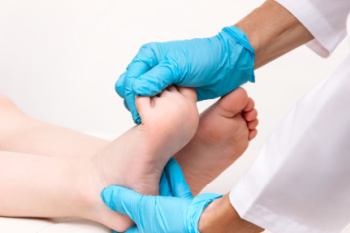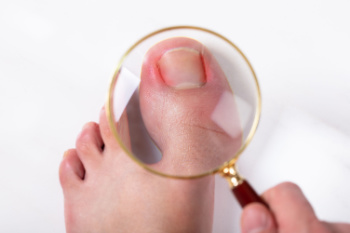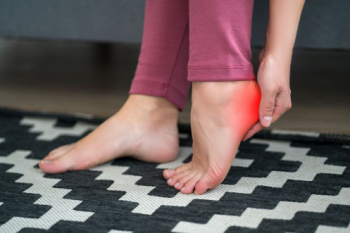Connect With Us
Blog
Items filtered by date: September 2024
Protecting Growing Feet

Children's foot health is important because their feet are growing and developing rapidly. In fact, younger feet grow faster, with toddlers needing new shoes every few months. Unlike adult feet, children’s feet can handle more stress, but they still need proper support to lay the foundation for a healthy body. Arch support for kids differs from adults, as children’s arches are still developing. Wearing proper footwear is essential to support growth and avoid issues later in life. Breathable materials like leather or mesh can help to manage sweaty feet, reducing the risk of infections. Proper shoe sizing is critical, with shoes fitting snugly but not too tight that can allow natural movement. For toddlers, soft-soled shoes provide flexibility as they learn to walk, while older children benefit from harder soles for better support and stability. If you have a child, it is suggested that you take them to a podiatrist for regular foot checkups to help ensure proper development and prevent future problems.
Making sure that your children maintain good foot health is very important as they grow. If you have any questions, contact one of our podiatrists of Brondon Foot and Ankle. Our doctors can provide the care you need to keep you pain-free and on your feet.
Keeping Children's Feet Healthy
Having healthy feet during childhood can help prevent medical problems later in life, namely in the back and legs. As children grow, their feet require different types of care. Here are some things to consider...
Although babies do not walk yet, it is still very important to take care of their feet.
Avoid putting tight shoes or socks on his or her feet.
Allow the baby to stretch and kick his or her feet to feel comfortable.
As a toddler, kids are now on the move and begin to develop differently. At this age, toddlers are getting a feel for walking, so don’t be alarmed if your toddler is unsteady or ‘walks funny’.
As your child gets older, it is important to teach them how to take care of their feet.
Show them proper hygiene to prevent infections such as fungus.
Be watchful for any pain or injury.
Have all injuries checked by a doctor as soon as possible.
Comfortable, protective shoes should always be worn, especially at play.
If you have any questions please feel free to contact our office located in Centerville, OH . We offer the newest diagnostic and treatment technologies for all your foot and ankle needs.
Managing Ingrown Toenails

Ingrown toenails occur when the edge of the toenail grows into the surrounding skin, causing pain and discomfort. This condition commonly affects the big toe and can result from improper nail trimming, wearing tight shoes, or genetic predisposition. Early symptoms include redness, swelling, and tenderness along the nail edges. If left untreated, ingrown toenails can lead to infection, abscesses, and chronic pain, which may complicate walking or lead to more severe health issues. Individuals with poor nail-cutting habits, wearing tight footwear, or certain foot deformities are at higher risk. Diagnosis typically involves a physical examination, during which a podiatrist will assess the nail and surrounding tissues. In some cases, an X-ray may be used to rule out other conditions. To address persistent ingrown toenails and prevent complications, it is suggested you schedule an appointment with a podiatrist for proper treatment and care.
Ingrown toenails can become painful if they are not treated properly. For more information about ingrown toenails, contact one of our podiatrists of Brondon Foot and Ankle. Our doctors can provide the care you need to keep you pain-free and on your feet.
Ingrown Toenails
Ingrown toenails occur when a toenail grows sideways into the bed of the nail, causing pain, swelling, and possibly infection.
Causes
- Bacterial infections
- Improper nail cutting such as cutting it too short or not straight across
- Trauma to the toe, such as stubbing, which causes the nail to grow back irregularly
- Ill-fitting shoes that bunch the toes too close together
- Genetic predisposition
Prevention
Because ingrown toenails are not something found outside of shoe-wearing cultures, going barefoot as often as possible will decrease the likeliness of developing ingrown toenails. Wearing proper fitting shoes and using proper cutting techniques will also help decrease your risk of developing ingrown toenails.
Treatment
Ingrown toenails are a very treatable foot condition. In minor cases, soaking the affected area in salt or antibacterial soaps will not only help with the ingrown nail itself, but also help prevent any infections from occurring. In more severe cases, surgery is an option. In either case, speaking to your podiatrist about this condition will help you get a better understanding of specific treatment options that are right for you.
If you have any questions please feel free to contact our office located in Centerville, OH . We offer the newest diagnostic and treatment technologies for all your foot and ankle needs.
Heel Spurs and How to Run If You Have Them

Heel spurs are bony growths that develop on the underside of the heel bone, often caused by chronic inflammation of the plantar fascia. They can lead to sharp pain, especially when walking or running. If you have a heel spur and want to continue running, it is important to take certain precautions. Choose well-cushioned, supportive shoes that help absorb impact and reduce stress on the heel. Engage in stretching exercises for the Achilles tendon and plantar fascia to improve flexibility and alleviate pressure. Running on softer surfaces, like grass or tracks, can also reduce the impact on your feet. Adjust your running routine by incorporating rest days and cross-training to avoid aggravating the condition. If you enjoy running and have developed a heel spur, it is suggested that you consult a podiatrist who can offer you additional relief solutions.
Heel spurs can be incredibly painful and sometimes may make you unable to participate in physical activities. To get medical care for your heel spurs, contact one of our podiatrists from Brondon Foot and Ankle. Our doctors will do everything possible to treat your condition.
Heels Spurs
Heel spurs are formed by calcium deposits on the back of the foot where the heel is. This can also be caused by small fragments of bone breaking off one section of the foot, attaching onto the back of the foot. Heel spurs can also be bone growth on the back of the foot and may grow in the direction of the arch of the foot.
Older individuals usually suffer from heel spurs and pain sometimes intensifies with age. One of the main condition's spurs are related to is plantar fasciitis.
Pain
The pain associated with spurs is often because of weight placed on the feet. When someone is walking, their entire weight is concentrated on the feet. Bone spurs then have the tendency to affect other bones and tissues around the foot. As the pain continues, the feet will become tender and sensitive over time.
Treatments
There are many ways to treat heel spurs. If one is suffering from heel spurs in conjunction with pain, there are several methods for healing. Medication, surgery, and herbal care are some options.
If you have any questions feel free to contact our office located in Centerville, OH . We offer the latest in diagnostic and treatment technology to meet your needs.
Facts About Cuboid Syndrome

Cuboid syndrome is a condition where the cuboid bone in the foot becomes partially dislocated, leading to pain and discomfort, typically on the outer side of the foot. It often occurs due to an injury, such as an ankle sprain, or from repetitive strain, especially in activities like running or jumping where the foot is under constant stress. Symptoms include sharp pain on the outer side of the foot, difficulty bearing weight, and sometimes swelling. The pain may worsen during activities that involve pushing off with the foot, such as walking, running, or jumping. Early diagnosis and treatment is vital. Treatment typically involves rest and immobilization to reduce inflammation, followed by targeted exercises to restore normal function. A podiatrist might also perform a cuboid manipulation to reposition the bone. Proper footwear, orthotics, and stretching exercises can help to prevent recurrence and support long-term foot health. If you have pain on the outside of your foot, it is suggested that you schedule an appointment with a podiatrist for a proper diagnosis and treatment.
Cuboid syndrome, also known as cuboid subluxation, occurs when the joints and ligaments near the cuboid bone in the foot become torn. If you have cuboid syndrome, consult with one of our podiatrists from Brondon Foot and Ankle. Our doctors will assess your condition and provide you with quality foot and ankle treatment.
Cuboid syndrome is a common cause of lateral foot pain, which is pain on the outside of the foot. The condition may happen suddenly due to an ankle sprain, or it may develop slowly overtime from repetitive tension through the bone and surrounding structures.
Causes
The most common causes of cuboid syndrome include:
- Injury – The most common cause of this ailment is an ankle sprain.
- Repetitive Strain – Tension placed through the peroneus longus muscle from repetitive activities such as jumping and running may cause excessive traction on the bone causing it to sublux.
- Altered Foot Biomechanics – Most people suffering from cuboid subluxation have flat feet.
Symptoms
A common symptom of cuboid syndrome is pain along the outside of the foot which can be felt in the ankle and toes. This pain may create walking difficulties and may cause those with the condition to walk with a limp.
Diagnosis
Diagnosis of cuboid syndrome is often difficult, and it is often misdiagnosed. X-rays, MRIs and CT scans often fail to properly show the cuboid subluxation. Although there isn’t a specific test used to diagnose cuboid syndrome, your podiatrist will usually check if pain is felt while pressing firmly on the cuboid bone of your foot.
Treatment
Just as the range of causes varies widely, so do treatments. Some more common treatments are ice therapy, rest, exercise, taping, and orthotics.
If you have any questions, please feel free to contact our office located in Centerville, OH . We offer the newest diagnostic and treatment technologies for all your foot care needs.

